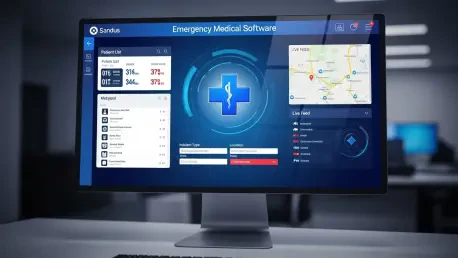Transforming Crisis Response: Setting the Stage for Analysis
Imagine a world where every second in a medical emergency is optimized, where technology bridges the gap between life and death with unparalleled precision, transforming crisis response into a seamless process. This is no longer a distant vision but a reality unfolding in the global Emergency Medical Software Market. With millions of lives at stake annually due to delayed responses or uncoordinated care, the stakes couldn’t be higher for innovative solutions that empower first responders and healthcare providers. This analysis delves into the current state and future trajectory of this critical industry, exploring how digital tools are revolutionizing emergency care. By examining key trends, technological advancements, and market dynamics, the goal is to uncover the forces driving substantial growth through 2031 and beyond.
Deep Dive into Market Dynamics and Projections
Technological Innovations Fueling Market Expansion
The Emergency Medical Software Market is experiencing a seismic shift, propelled by cutting-edge technologies that enhance the speed and accuracy of emergency responses. Cloud-based platforms have emerged as a cornerstone, offering scalability and real-time data access that enable seamless coordination between dispatch centers, ambulances, and hospitals. Artificial Intelligence (AI) is another game-changer, with predictive analytics and automated triage systems helping prioritize patient care based on urgency. These advancements are not mere upgrades but essential tools that reduce mortality rates by ensuring rapid, informed decision-making in high-pressure scenarios.
Moreover, mobile-first designs are gaining traction, catering to the on-the-go nature of emergency professionals. Integration with telemedicine further amplifies impact, allowing remote consultations during patient transit. As of now, the market is witnessing a surge in adoption of these technologies, with projections indicating a robust compound annual growth rate from 2025 to 2031. This momentum underscores a clear trend: technology is becoming the backbone of modern emergency healthcare, setting the stage for widespread transformation.
Interoperability as a Critical Growth Driver
A pivotal factor shaping the market is the push for interoperability across emergency networks. Modern software solutions are designed to create a unified ecosystem, connecting diverse entities such as emergency rooms, paramedic teams, and administrative bodies. This connectivity minimizes errors, optimizes resource allocation, and ensures that patient information flows smoothly across platforms. For instance, real-time location tracking ensures ambulances take the fastest routes, while integrated systems allow hospitals to prepare for incoming cases well in advance.
However, achieving seamless interoperability remains a challenge, particularly when integrating legacy systems with newer technologies. Compatibility issues can disrupt communication during large-scale crises, highlighting the need for standardized protocols. Despite these hurdles, the opportunity to build cohesive networks is driving investment, with industry stakeholders prioritizing collaborative efforts to enhance system reliability. This focus on integration is expected to be a key catalyst for market growth over the next several years.
Addressing Cybersecurity and Regional Variations
As the market expands, cybersecurity emerges as a non-negotiable priority due to the sensitive nature of patient data handled by emergency medical software. Compliance with stringent regulations like HIPAA in the United States is shaping product development, requiring constant updates to counter evolving digital threats. Breaches in security could undermine trust and hinder adoption, making robust encryption and secure design critical components of market strategies.
Simultaneously, regional disparities present both challenges and opportunities. North America and Europe lead in adoption, thanks to advanced digital health infrastructures and supportive policies. In contrast, emerging markets in Asia-Pacific and Africa, while showing rapid urbanization, grapple with infrastructure gaps that slow implementation. Tailored solutions and public-private partnerships are seen as vital to bridging these divides, ensuring that life-saving technologies reach underserved areas. Balancing security with accessibility across diverse regions remains a complex but essential task for sustained market growth.
Future Trends and Market Predictions
Looking toward the horizon, the market is set to witness a wave of innovation that will redefine emergency care by 2031. AI is expected to deepen its role with advanced predictive modeling, enabling responders to anticipate critical needs before they escalate. Cloud-based systems will likely dominate, offering unmatched flexibility even in remote locales, while augmented reality could revolutionize training for emergency personnel. Regulatory shifts globally are also anticipated to mandate stricter interoperability standards, fostering greater cohesion across systems.
Economic factors, such as rising healthcare expenditures in developing regions, are projected to accelerate adoption rates. Competitive pressures will drive companies to innovate continuously, introducing features like enhanced billing integration and comprehensive records management. These trends point to a future where emergency medical software becomes an integral pillar of global healthcare, with market expansion reflecting both technological progress and a commitment to equitable access.
Reflecting on Insights and Charting the Next Steps
Looking back, the analysis of the Emergency Medical Software Market reveals a landscape brimming with potential, driven by technological breakthroughs and a pressing need for efficient crisis response. The journey from fragmented, manual processes to sophisticated digital ecosystems marks a profound shift in how emergencies are managed. Key implications from this growth trajectory underscore the importance of innovation, interoperability, and security as foundational elements that shape success.
For stakeholders, the path forward demands strategic investments in scalable, user-friendly solutions that prioritize both functionality and compliance. Businesses need to focus on developing platforms adaptable to diverse regional needs, while policymakers must champion funding initiatives to close infrastructure gaps in emerging markets. Training programs for emergency professionals emerge as a crucial step to ensure smooth technology adoption. Ultimately, the collective effort to expand access and enhance capabilities promises a future where every community benefits from cutting-edge tools, turning critical moments into opportunities for life-saving intervention.









